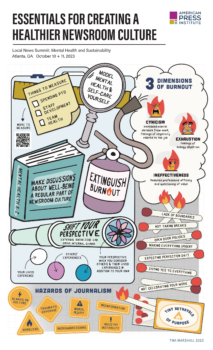3 ways to measure well-being in news organizations
Jan Ross P. Sakian, American Press Institute, Here’s an idea to steal and adapt: Identify micro-goals to support individual and organizational change.
Here’s an idea to steal and adapt: Identify micro-goals to support individual and organizational change. Better News is highlighting practical resources to support journalists and news organizations for Mental Health Awareness Month. This piece features insights from a May 2024 Need to Know special edition series created by Samantha Ragland, vice president of Journalism Strategy at the American Press Institute.
What does better mental health in the news industry look like to you?
This Mental Health Awareness Month, Better News is sharing ideas for how to reinforce well-being in news organizations and chart healthy pathways for journalists in the workplace. These approaches can be applied any time.
Samantha Ragland, vice president of Journalism Strategy at the American Press Institute, developed the Measuring Well-being challenge to help journalists and news leaders consider, establish and implement best practices to support mental health in news organizations.
Here’s an overview of three frameworks to try:
Craft your ‘From/to’ statements
When it comes to challenging and changing the culture of local news organizations, Ragland suggests starting with the basics by stepping back from the complexities.
“From/to” statements can help you envision a clear, concise direction. Consider where you are now versus where you aspire to be – in your organization, as a news leader, or as an individual contributor.
Use this formula to start your statement: A WHO + Does a WHAT + For a PERSON, PLACE OR THING
Write two brief statements: one describing where you are today – a present state – and one describing where you aspire to be – a future state.
One example that Ragland shared:
| Present State | 👉 | Future State |
| A team that hasn’t had intentional conversations around burnout and exposure to trauma and how it may be impacting us | A team that has shared language, recognizes the effects of burnout and trauma and is proactive about addressing them |
You can use these statements to check for existing best practices and work with your team to think of ways to get your organization closer to the future state you all envision.
Keep in mind that organizational culture change won’t happen overnight, Ragland says. Tempering expectations and being committed to the long game is critical for measuring and sustaining newsroom well-being.
You can read more details and additional “from/to” statement examples from API’s Local News Summit on Mental Health and Sustainability.
Identify needs for workplace mental health and well-being
To support a sustainable workplace culture that can be measured and iterated upon, Ragland notes the importance of connecting your goals to larger systems.
She suggests categorizing your desired future state within the U.S. Surgeon General’s Framework for Workplace Mental Health and Well‑Being.
The framework outlines 5 essentials, each grounded in two human needs:
- Protection from harm
- Safety
- Security
- Connection & community
- Belonging
- Social support
- Work-life harmony
- Autonomy
- Flexibility
- Mattering at work
- Dignity
- Meaning
- Opportunity for growth
- Accomplishment
- Learning
These needs are shared across industries, roles and people. So how can you apply this approach to a newsroom? Read more about how “from/to” statements can evolve into developing OKRs — objectives and key results — to fit your workplace.
Figure out how data can support change
Creating a key performance indicator or goal is one way to quantify measures toward improving well-being. Ragland outlines these steps:
- Assign a data point to reach: “To evolve from aspirational to measurable, you need a specific target, one that has a stretch but achievable metric tied to it,” Ragland says, “This target should be just as memorable as your from/to statement.”
- Decide how long it will take: “Policy changes can take a year or more to come to fruition, but team changes can happen much faster,” Ragland says. “Six- to 12-month time frames are ideal and allow a more proactive response to the trauma-facing nature of our industry.”
- Choose the data source to track: Tracking can be done through existing institutional systems like an employee navigator portal, or sometimes a survey or some other process leads to the creation of a new system.
- Set a frequency to monitor: How often will you collect or pull the data? And how will this fit into the larger time frame? Adjust the frequency and expectations around work styles, demands on the team and the mechanics of the data source you have in mind.
The four steps can be combined in a simple formula for measuring desired change: Target + Timeframe + Data Source + Frequency = Measuring Well-being
The micro-goals identified can fit into a larger framework supporting an overall strategy for change. Here’s one example from Ragland:
| Objective (future state) | Managers cultivate supportive relationships where they model care and promote benefits that can help journalists | ||
| Workplace Essential | Mattering at work | ||
| Performance Indicator (key result) | PTO is taken throughout the year, not just around holidays | ||
| Target | Timeframe | Data Source | Frequency |
| 50% of newsroom PTO is not holiday-adjacent | 6 months | PTO tracking system through HR | Quarterly |
More resources
Try these other “challenges series” from Ragland to assess and improve well-being in your workplace:
- Balancing Well-being: Twenty daily actions to help you prioritize your well-being with ideas to support journalists and organizations taking deliberate steps toward healthy habits and self-awareness
- Mental health reset: A 4-week challenge to build healthy habits for responsive teams.
For Mental Health Awareness Month, API is also hosting free, interactive virtual sessions:
- Beyond Stress: What journalists should know about burnout from 1 to 2 p.m. ET on May 6, 2025.
- Trauma-informed leadership from 1 to 2 p.m. ET on May 27, 2025.
Year-round, you can also read through API’s Mental Health resource guide or share this illustration on the essentials for creating a healthier newsroom workplace.